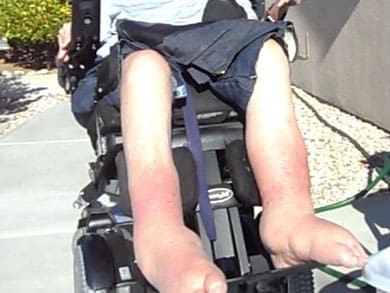Report by Nicola Falconer
A recent study has found the presence of chronic lower limb oedema (CLLO) in multiple sclerosis patients (MS) to be 62% . These findings were reported by Dr Vaughan Keeley, Derby Hospital, UK, at the Asia Pacific Lymphology conference held in Darwin last month.
People who have MS often experience swollen legs, or oedema. Oedema can occur for a number of reasons, particularly if it has become difficult to walk.
Dr Vaughan is currently researching:
the proportion of people with MS (known to the neurology or rehabilitation medicine services of a chosen hospital) who experience leg swelling
how severe leg swelling is amongst those who have it, what factors might precipitate swelling and what problems it creates in everyday life
and the extent to which leg swelling is unrecognised by patients.
Previous research has estimated CLLO to be 45% and 85% respectively in patients with MS (Solaro, 2006; Arpaia, 2010).
Keeley conducted his research using 607 subjects known to one hospital. He administered a self-reporting questionnaire and the Multiple Sclerosis Walking Scale (MSWS-12) finding a relationship between CLLO and reduced mobility. He also found that subjects who had diabetes or previous cellulitis had higher incidences of CLLO. The other significant finding is that almost 1/3 of subjects diagnosed with CLLO didn’t recognise they had oedema.
Reasons for oedema in MS patients can include:
reduced mobility
increased dependency
autonomic dysfunction
post-thrombotic syndrome
disease modifying treatments (for example, corticosteroids used to treat MS)
other co-morbidities
Swollen legs can be painful and uncomfortable and make it more difficult to walk or to transfer. When severe, the skin can develop ulcers and infections that may require treatment and admissions to hospital. While therapists can implement modifications to the those patients in wheelchairs, such as leg-rest elevation and tilt-in-space, these strategies may not be enough.
It is important to diagnose oedema early to avoid secondary complications. Without appropriate treatment to reduce the swelling, tissues become hard due to the accumulation of waste products and the failure of the lymphatic system to drain excess fluid. Over time, this can transform oedema into lymphoedema where the underlying lymph system cannot operate correctly.
The affected tissues become fibrotic and oedema fails to reduce on elevation. A diagnostic test for this is Stemmer’s sign, which is when a fold of skin cannot be pinched or picked up from the base of the second toe. By this stage, the symptoms are often irreversible but can be managed.
Treatment for oedema may include:
Exercises/limb elevation
Compression: garments, bandaging, pneumatic pumps
Skin care + emollients
Manual lymphatic drainage at a lymphoedema clinic
It is important for the oedema to be identified, diagnosed and managed early and comprehensively by a vascular specialist or lymphoedema therapist.
For more information on where to get help visit the Australian Lymphology Association.
References
Bianchi J , Vowden K , Whitaker J, (2012), ‘Chronic oedema made easy’, Wounds UK, Vol 8, Issue 2.
Keeley, V (2016), ‘The prevalence of chronic lower limb oedema (CLLO) in multiple sclerosis (MS)’, Conference Proceedings 2016 Asia Pacific Lymphology Conference, May 2016.
Keeley, V. (2008), “Drugs that may exacerbate and those used to treat lymphoedema” Journal of Lymphoedema, Vol 3, No 1



